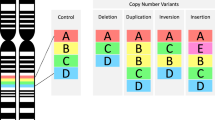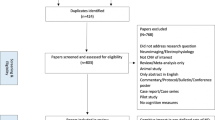Abstract
In a small fraction of patients with schizophrenia or autism, alleles of copy-number variants (CNVs) in their genomes are probably the strongest factors contributing to the pathogenesis of the disease. These CNVs may provide an entry point for investigations into the mechanisms of brain function and dysfunction alike. They are not fully penetrant and offer an opportunity to study their effects separate from that of manifest disease. Here we show in an Icelandic sample that a few of the CNVs clearly alter fecundity (measured as the number of children by age 45). Furthermore, we use various tests of cognitive function to demonstrate that control subjects carrying the CNVs perform at a level that is between that of schizophrenia patients and population controls. The CNVs do not all affect the same cognitive domains, hence the cognitive deficits that drive or accompany the pathogenesis vary from one CNV to another. Controls carrying the chromosome 15q11.2 deletion between breakpoints 1 and 2 (15q11.2(BP1-BP2) deletion) have a history of dyslexia and dyscalculia, even after adjusting for IQ in the analysis, and the CNV only confers modest effects on other cognitive traits. The 15q11.2(BP1-BP2) deletion affects brain structure in a pattern consistent with both that observed during first-episode psychosis in schizophrenia and that of structural correlates in dyslexia.
This is a preview of subscription content, access via your institution
Access options
Subscribe to this journal
Receive 51 print issues and online access
$199.00 per year
only $3.90 per issue
Buy this article
- Purchase on Springer Link
- Instant access to full article PDF
Prices may be subject to local taxes which are calculated during checkout



Similar content being viewed by others
Change history
15 January 2014
A middle initial was added in the author list.
References
Stefansson, H. et al. Large recurrent microdeletions associated with schizophrenia. Nature 455, 232–236 (2008)
Kirov, G. et al. The penetrance of copy number variations for schizophrenia and developmental delay. Biol. Psychiatry (2013)
Malhotra, D. & Sebat, J. CNVs: harbingers of a rare variant revolution in psychiatric genetics. Cell 148, 1223–1241 (2012)
Haukka, J., Suvisaari, J. & Lonnqvist, J. Fertility of patients with schizophrenia, their siblings, and the general population: a cohort study from 1950 to 1959 in Finland. Am. J. Psychiatry 160, 460–463 (2003)
Sheehan, D. V. et al. The Mini-International Neuropsychiatric Interview (M.I.N.I.): the development and validation of a structured diagnostic psychiatric interview for DSM-IV and ICD-10. J. Clin. Psychiatry 59 (Suppl. 20). 22–33 quiz 34–57 (1998)
Meins, W., Jacobsen, G. & Stratmann, C. Social adjustment of psychiatric patients: evaluation of a modified version of the GAF (Global Assessment of Functioning) Scale. [in German with English abstract] Psychiatr. Prax. 22, 206–208 (1995)
Sitskoorn, M. M., Aleman, A., Ebisch, S. J., Appels, M. C. & Kahn, R. S. Cognitive deficits in relatives of patients with schizophrenia: a meta-analysis. Schizophr. Res. 71, 285–295 (2004)
Snitz, B. E., Macdonald, A. W., III & Carter, C. S. Cognitive deficits in unaffected first-degree relatives of schizophrenia patients: a meta-analytic review of putative endophenotypes. Schizophr. Bull. 32, 179–194 (2006)
Mesholam-Gately, R. I., Giuliano, A. J., Goff, K. P., Faraone, S. V. & Seidman, L. J. Neurocognition in first-episode schizophrenia: a meta-analytic review. Neuropsychology 23, 315–336 (2009)
Rund, B. R. A review of longitudinal studies of cognitive functions in schizophrenia patients. Schizophr. Bull. 24, 425–435 (1998)
Bjornsdottir, G. et al. The adult reading history questionnaire (ARHQ) in Icelandic: psychometric properties and factor structure. J. Learn. Disabil. (2013)
Lefly, D. L. & Pennington, B. F. Reliability and validity of the adult reading history questionnaire. J. Learn. Disabil. 33, 286–296 (2000)
Jacquemont, S. et al. Mirror extreme BMI phenotypes associated with gene dosage at the chromosome 16p11.2 locus. Nature 478, 97–102 (2011)
Weiss, L. A. et al. Association between microdeletion and microduplication at 16p11.2 and autism. N. Engl. J. Med. 358, 667–675 (2008)
McCarthy, S. E. et al. Microduplications of 16p11.2 are associated with schizophrenia. Nature Genet. 41, 1223–1227 (2009)
Park, S. & Holzman, P. S. Schizophrenics show spatial working memory deficits. Arch. Gen. Psychiatry 49, 975–982 (1992)
Doornbos, M. et al. Nine patients with a microdeletion 15q11.2 between breakpoints 1 and 2 of the Prader-Willi critical region, possibly associated with behavioural disturbances. Eur. J. Med. Genet. 52, 108–115 (2009)
Burnside, R. D. et al. Microdeletion/microduplication of proximal 15q11.2 between BP1 and BP2: a susceptibility region for neurological dysfunction including developmental and language delay. Hum. Genet. 130, 517–528 (2011)
de Kovel, C. G. et al. Recurrent microdeletions at 15q11.2 and 16p13.11 predispose to idiopathic generalized epilepsies. Brain 133, 23–32 (2010)
World Health Organization. ICD-10: International Statistical Classification of Diseases and Related Health Problems 10th edn (WHO, 2008)
Radua, J. et al. Multimodal meta-analysis of structural and functional brain changes in first episode psychosis and the effects of antipsychotic medication. Neurosci. Biobehav. Rev. 36, 2325–2333 (2012)
Diorio, D., Viau, V. & Meaney, M. J. The role of the medial prefrontal cortex (cingulate gyrus) in the regulation of hypothalamic-pituitary-adrenal responses to stress. J. Neurosci. 13, 3839–3847 (1993)
Lederbogen, F. et al. City living and urban upbringing affect neural social stress processing in humans. Nature 474, 498–501 (2011)
Seeley, W. W. et al. Dissociable intrinsic connectivity networks for salience processing and executive control. J. Neurosci. 27, 2349–2356 (2007)
Palaniyappan, L. & Liddle, P. F. Does the salience network play a cardinal role in psychosis? An emerging hypothesis of insular dysfunction. J. Psychiatry Neurosci. 37, 17–27 (2012)
Bora, E. et al. Neuroanatomical abnormalities in schizophrenia: a multimodal voxelwise meta-analysis and meta-regression analysis. Schizophr. Res. 127, 46–57 (2011)
Arnone, D., McIntosh, A. M., Tan, G. M. & Ebmeier, K. P. Meta-analysis of magnetic resonance imaging studies of the corpus callosum in schizophrenia. Schizophr. Res. 101, 124–132 (2008)
Tan, G. M., Arnone, D., McIntosh, A. M. & Ebmeier, K. P. Meta-analysis of magnetic resonance imaging studies in chromosome 22q11.2 deletion syndrome (velocardiofacial syndrome). Schizophr. Res. 115, 173–181 (2009)
Linkersdörfer, J., Lonnemann, J., Lindberg, S., Hasselhorn, M. & Fiebach, C. J. Grey matter alterations co-localize with functional abnormalities in developmental dyslexia: an ALE meta-analysis. PLoS ONE 7, e43122 (2012)
Rotzer, S. et al. Optimized voxel-based morphometry in children with developmental dyscalculia. Neuroimage 39, 417–422 (2008)
Hall, R. C. Global assessment of functioning. A modified scale. Psychosomatics 36, 267–275 (1995)
Wechsler, D. Wechsler Memory Scale 3rd edn (Harcourt Brace and Company, 1997)
Benton, A. H. K. Multilingual Aphasia Examination (AJA Associates, 1989)
Morris, J. C. et al. The Consortium to Establish a Registry for Alzheimer's Disease (CERAD). Part I. Clinical and neuropsychological assessment of Alzheimer's disease. Neurology 39, 1159–1165 (1989)
Stroop, J. R. Studies of interference in seral verbal reactions. J. Exp. Psychol. 18, 643–662 (1935)
Reitan, R. M. Validity of the trail making test as an indicator of organic brain damage. Percept. Mot. Skills 8, 271–276 (1958)
Berg, E. A. A simple objective test for measuring flexibility in thinking. J. Gen. Psychol. 39, 15–22 (1948)
Owen, A. M., Downes, J. J., Sahakian, B. J., Polkey, C. E. & Robbins, T. W. Planning and spatial working memory following frontal lobe lesions in man. Neuropsychologia 28, 1021–1034 (1990)
Sahakian, B., Jones, G., Levy, R., Gray, J. & Warburton, D. The effects of nicotine on attention, information processing, and short-term memory in patients with dementia of the Alzheimer type. Brit. J. Psychiatry 154, 797–800 (1989)
Wechsler, D. Wechsler Abbreviated Scale of Intelligence (Harcourt Brace and Company, 1999)
Wang, K. et al. PennCNV: an integrated hidden Markov model designed for high-resolution copy number variation detection in whole-genome SNP genotyping data. Genome Res. 17, 1665–1674 (2007)
Hall, R. C. & Parks, J. The modified global assessment of functioning scale: addendum. Psychosomatics 36, 416–417 (1995)
Golden, C. J. The Stroop color word test (Stoelting Company, 1978)
Heaton, R., Chelune, G., Talley, J., Kay, G. & Curtis, G. Wisconsin Card Sorting Test manual (Psychological Assessment Resources, 1993)
Feigenbaum, J. D., Polkey, C. E. & Morris, R. G. Deficits in spatial working memory after unilateral temporal lobectomy in man. Neuropsychologia 34, 163–176 (1996)
Ashburner, J. & Friston, K. J. Unified segmentation. Neuroimage 26, 839–851 (2005)
Manjón, J. V., Coupe, P., Marti-Bonmati, L., Collins, D. L. & Robles, M. Adaptive non-local means denoising of MR images with spatially varying noise levels. J. Magn. Reson. Imaging 31, 192–203 (2010)
Ashburner, J. A fast diffeomorphic image registration algorithm. Neuroimage 38, 95–113 (2007)
Acknowledgements
The authors are grateful to the participants and we thank the research nurses and staff at the Krókháls recruitment centre and roentgentechnicians at Röntgen Domus. We also thank the staff at deCODE genetics core facilities and all our colleagues for their important contribution to this work. The research leading to these results has received support from the Innovative Medicines Initiative Joint Undertaking under grant agreement no. 115008 of which resources are composed of EFPIA in-kind contribution and financial contribution from the European Union's Seventh Framework Programme (FP7/2007-2013) and EU funded FP7-People-2011-IAPP grant PsychDPC (GA 286213).
Author information
Authors and Affiliations
Contributions
H.St., A.M-L., S.S., B.M., S.A., G.B., G.B.W., M.D., T.B.S., M.B., S. Ka., J.H., S.H., E.Sa., E.Si. and K.S. were involved in study design. B.M., S.A., G.A.J., S. Kr., H.Sn., S.R.D., B.S., I.H., M.H., B.J., J.G.H., S.H., E.Sa. and E.Si. were involved with cohort ascertainment, phenotypic characterization and recruitment. H.St., K.M., G.B., G.B.W., O.M.D., H.T., O.G., G.F.J., J.H.T and L.J.G. were involved with informatics and data management. H.St., A.M-L., S.S., K.M., G.B., G.B.W., O.M.D., H.T., O.G., M.B. and A.J.S. carried out statistical analysis. H.St., A.M-L., S.S., B.M., K.M., S.A., G.B., G.B.W., G.A.J., O.M.D., H.T., O.G., S. Kr., H.Sn., S.R.D., L.J.G., G.F.J., B.S., I.H., M.H., B.J., J.H.T., M.D., T.B.S., M.B., S. Ka., J.G.H., S.H., E.Sa., E.Si. and K.S. wrote the manuscript.
Corresponding authors
Ethics declarations
Competing interests
H.St., S.S., S.A., G.B., G.B.W., G.J., S. Kr., H.Sn., S.R.D., L.J.G., G.F.J., B.S. and K.S. are employees of deCODE genetics/Amgen. B.J. is an employee of Röntgen domus. A.J.S. is an employee of Eli Lilly and Company. M.D. and T.B.S. are employees of H. Lundbeck A/S.
Additional information
The authors declare competing financial interests: details are available in the online version of the paper.
Supplementary information
Supplementary Information
This file contains Supplementary Figure 1, Supplementary Tables 1-7 and Supplementary References. (PDF 409 kb)
Supplementary Data
This file contains Supplementary Table 8. (XLSX 23 kb)
Rights and permissions
About this article
Cite this article
Stefansson, H., Meyer-Lindenberg, A., Steinberg, S. et al. CNVs conferring risk of autism or schizophrenia affect cognition in controls. Nature 505, 361–366 (2014). https://doi.org/10.1038/nature12818
Received:
Accepted:
Published:
Issue Date:
DOI: https://doi.org/10.1038/nature12818
This article is cited by
-
Intrauterine ultrasound phenotyping, molecular characteristics, and postnatal follow-up of fetuses with the 15q11.2 BP1-BP2 microdeletion syndrome: a single-center, retrospective clinical study
BMC Pregnancy and Childbirth (2024)
-
Behavioral Phenotypes and Comorbidity in 3q29 Deletion Syndrome: Results from the 3q29 Registry
Journal of Autism and Developmental Disorders (2024)
-
High level of complexity and global diversity of the 3q29 locus revealed by optical mapping and long-read sequencing
Genome Medicine (2023)
-
The genetic landscape and clinical implication of pediatric Moyamoya angiopathy in an international cohort
European Journal of Human Genetics (2023)
-
Family-based analysis of the contribution of rare and common genetic variants to school performance in schizophrenia
Molecular Psychiatry (2023)
Comments
By submitting a comment you agree to abide by our Terms and Community Guidelines. If you find something abusive or that does not comply with our terms or guidelines please flag it as inappropriate.



